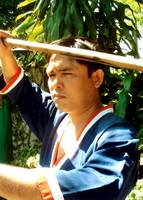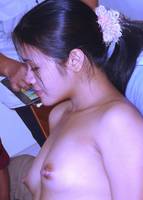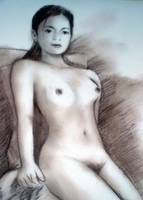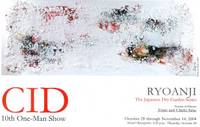dandy roy: from martial to visual arts
When his 1993 fight at a prestigious martial arts tournament in Phuket, Thailand did not materialize, this young master had to fight for subsistence in Manila. Stranded and disillusioned, like a typical provinciano who had gone astray at the heart of the metropolis, and with nothing in his pocket but a handful of dreams, he had yet to face the greatest fight of his life - a fight for survival - to assuage the pains of his hungering soul and stomach.
Instead of using his martial arts expertise in hunting for a job, he reluctantly dropped the “martial” but embraced the “arts” and from there, life was never the same for this award-winning eskrima master turned painter from Davao.
Dandy Roy’s still life paintings are teeming with geometric forms and colors. His esoteric subjects are reflective of his origin where ethnic foods are given with new meanings as they ingeniously appear on his canvas. The queer juxtapositions of tribal delicacies such as the lut (a bamboo tube where the native fish is cooked), the grilled uâbang (mountain shrimp), the steamed casili (eel), and other mouth-watering ethnic recipes are lusciously portrayed with dynamism on his canvas. The ensuing images are sensuously delectable and exotic.
Instead of using his martial arts expertise in hunting for a job, he reluctantly dropped the “martial” but embraced the “arts” and from there, life was never the same for this award-winning eskrima master turned painter from Davao.
Dandy Roy’s still life paintings are teeming with geometric forms and colors. His esoteric subjects are reflective of his origin where ethnic foods are given with new meanings as they ingeniously appear on his canvas. The queer juxtapositions of tribal delicacies such as the lut (a bamboo tube where the native fish is cooked), the grilled uâbang (mountain shrimp), the steamed casili (eel), and other mouth-watering ethnic recipes are lusciously portrayed with dynamism on his canvas. The ensuing images are sensuously delectable and exotic.
Still Life, Acrylic on Canvas By Dany Roy, 2003.
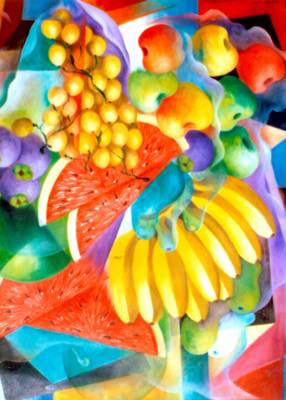
Photo by Danny Sillada Copyright 2005. Posted by Hello

Photo by Danny Sillada Copyright 2005. Posted by Hello
His journey begun from a remote town at the Eastern part of Davao province, a coastal town called Baganga, which is sandwiched between the lush mountains and the Pacific Ocean. In the 70’s and 80’s, this paradise-like place used to be a progressive town among other towns in the first district of Davao Oriental, where the logging concessionaires still stationed, reaping mercilessly the virginal forests of the entire district.
As a young lad, he benefited from the economic surge of his town by peddling his coco-wine (locally known as tubâ) to the logging workers. As a mananggeté or a winemaker, which he would proudly assert today, he supported his siblings and his own studies at school. His assiduous dedication to his humble profession at a very tender age was exceptional, sacrificing his personal needs and happiness for the betterment of his family.
He would rise early at dawn with cawit (bamboo container) fastened on his left shoulder and a sang’got (a sharp boomerang-shape blade) tucked on his waist, then climb as many coconut trees as he could to percolate the extracted juices from the cawit that was attached overnight to the sliced shoots of the coconut tree. The freshly harvested juices would then be processed and mixed with tungog, a red powder that served as coloring and taste enhancer, so that by seven o’clock in the morning, he was already off to school after delivering his gallons of product to the different tiangge (tubâ vendor).
His perseverance was finally rewarded when he graduated from high school out of his own dexterity and independence. He then dreamed of going to college in Davao City that was 800 kilometers away from his town. However, due to the financial constraint, his dream died before it could flourish. Disappointed and tired of his routine as a winemaker, he went into the mountains, not to become a rebel, but to live a hermitage life.
In 1981, after two years of living an ascetic life, he began to question the purpose and meaning of his existence. And like Albert Camus’ awakening, Dandy Roy suddenly found in him an ‘invincible summer’ when he decided to come out from his lonely delitescence and go back to his family and friends as a new and mature person. This time, determined to pursue his dream of studying in college, he began to unravel the beginning of his life’s journey in a distant place away from his land.
In the same year, he took up Electrical Engineering at the University of Mindanao in Davao City. However, his stint at the university was cut short when, in 1982, he decided to sail to the island of Cebu to shift in another course on BS Marine Transportation at the University of Cebu, then Cebu Central Colleges. Almost simultaneously, he also began his rigorous training in martial arts under the legendary grandmaster, Ciriaco Cañete, a world-renowned grandmaster in arnis and one of the founding members of Doce Pares.
Aside from his growing skills in kali and arnis, he went on further to learn in other fields of martial arts such as Karate, Judo and Jujitsu. In the following year, as a brilliant student with athletic physique, he was hired by his grandmaster as assistant instructor in the same university, which later, he would become a sports celebrity in the campus.
Then 1988 came, as the luckiest and the busiest year for this fully grown man who almost buried his dreams into the wilderness of his town. He bagged two championships in martial arts competitions being the national champion in Karate, open competition, under the Central Visayas Karate Association, and national champion in arnis, welterweight division, sponsored by the World Eskrima Kali Arnis Federation, which was organized by some Hollywood personalities (stuntmen) such as Dan Inosanto, Fred Degre Berg, Richard Bustillo, to name a few, headed by Grandmaster Ciriaco Cañete.
His tours de force performance in martial arts earned him four different prestigious titles as Black Belt (4th Dan) in Arnis, Brown Belt (4th Kyu) in Judo, Black Belt (1st Dan) in Jujitsu, and Black Belt (1st Dan) in Karate. He was then one of the best and most sought-after instructors at that time, needless to mention his being the protégée of the grandmaster.
Meanwhile, in the same year, Lito Osmeña, then governor of Cebu, took notice of his growing popularity in martial arts, hired him through his grandmaster to train the Barangay Tanod members on tactical defense as part of the Department of Affairs’ program in suppressing criminalities in the city. Almost simultaneously, the Military Air Force hired him for his tactical combat expertise to train the Air Force officers and Air Force Police on Anti-Terrorist and Tactical Combat Defense program at Mactan Air Force, Cebu.
Despite the accolades and success, however, after a long strenuous routine as a martial arts instructor, his passion slowly wizened when he finally finished his studies in BS Marine Transportation in 1989. After making a difficult decision, he reluctantly left his post and his grandmaster with a heavy heart.
By 1990, he then went on in another journey, farther and away from his land, on an inter-island tramping vessel sailing through Philippine islands and, at times, in the neighboring Asian countries such as Malaysia and Singapore.
In the first quarter of 1993, after sailing for two years in the vast horizon of the sea, he anchored back home in his hometown in Baganga, Davao Oriental to see and embrace the people whom he dearly loved, the same people who gave him a reason to dream , which he eventually achieved through persistence and hard work. It was also in this town that he finally found the harbor that he had been longing in his heart, a lovely woman named Gemma, who began to fill the emptiness of his life.
Shortly after his brief vacation in his town, together with his newfound love and inspiration, he sailed again and this time, bound for Manila to prepare for an impending international martial arts tournament in Bangkok. In Manila, he was supposed to meet a friend; his would be teammate, Christopher Petrelle, who would be sponsoring his trip to Thailand. But Petrelle did not arrive to Manila because of a freak accident - a long jump as paratrooper in Australia that caused several bone fractures on his lower body.
With no adequate funds, he and Gemma stayed at their relatives, a known and established artist William Yu, at San Jose Village in Alabang. There, he also met his younger brother, Adrian Morales, an emerging artist who was an apprentice to William Yu. Consequently, as he began to associate with different artists in Manila, Dandy Roy slowly awakened his artistic passion and saw its potential as a source for subsistence.
After finding himself in the company of veteran artists like William Yu, Loreto Racuya and the late Isabelo Quiles, to name a few, being the odd man out, Dandy Roy finally joined them. As a fledgling artist then, he was agog to learn and relearn the rudiments of arts from the masters. One of them was Loreto Racuya who became his mentor in painting, and at the same time, his diligent student in martial arts particularly in arnis.
By 1997, Dandy Roy was lucky enough to meet the father of both struggling and established artists in the person of Atty. Mario Alcantara, the founder of Heritage Gallery, who saw the great potential in his art. At first, he was asked by his newfound patron to deliver one painting a week who, not only inspired him to paint, but also gave him tips on works that are saleable in the market. Later, Atty. Alcantara began to require him to submit more paintings, as the demand of his works grew bigger in the market.
He woke up one day in disbelief, as if in a euphoric dream, when he realized that his paintings had already been circulating in the market - being sought by art collectors and dealers alike. And who would believe either that this chameleon from terra incognita could metamorphose himself from a lowly mananggeté (coco-wine maker) to a martial arts expert and from a humble seaman to a promising visual artist.
Today Dandy Roy could only sigh with relief if he remembers his sinuous journey. He would rationalize that life is like an intricate process of making a coco-wine, or like martial arts where you have to counter-attack using your opponent’s own force, or like an ocean to be sailed and navigated, or like an empty canvas to be filled with forms and colors. As an optimist with undaunted dreams and vision, he still struggles to live day by day by conjuring up his art one at a time.
“My philosophy in life”, he said audaciously,”…is that, you have to make it happen, otherwise, nothing will happen to you!”
Meanwhile, in the same year, Lito Osmeña, then governor of Cebu, took notice of his growing popularity in martial arts, hired him through his grandmaster to train the Barangay Tanod members on tactical defense as part of the Department of Affairs’ program in suppressing criminalities in the city. Almost simultaneously, the Military Air Force hired him for his tactical combat expertise to train the Air Force officers and Air Force Police on Anti-Terrorist and Tactical Combat Defense program at Mactan Air Force, Cebu.
Despite the accolades and success, however, after a long strenuous routine as a martial arts instructor, his passion slowly wizened when he finally finished his studies in BS Marine Transportation in 1989. After making a difficult decision, he reluctantly left his post and his grandmaster with a heavy heart.
By 1990, he then went on in another journey, farther and away from his land, on an inter-island tramping vessel sailing through Philippine islands and, at times, in the neighboring Asian countries such as Malaysia and Singapore.
In the first quarter of 1993, after sailing for two years in the vast horizon of the sea, he anchored back home in his hometown in Baganga, Davao Oriental to see and embrace the people whom he dearly loved, the same people who gave him a reason to dream , which he eventually achieved through persistence and hard work. It was also in this town that he finally found the harbor that he had been longing in his heart, a lovely woman named Gemma, who began to fill the emptiness of his life.
Shortly after his brief vacation in his town, together with his newfound love and inspiration, he sailed again and this time, bound for Manila to prepare for an impending international martial arts tournament in Bangkok. In Manila, he was supposed to meet a friend; his would be teammate, Christopher Petrelle, who would be sponsoring his trip to Thailand. But Petrelle did not arrive to Manila because of a freak accident - a long jump as paratrooper in Australia that caused several bone fractures on his lower body.
With no adequate funds, he and Gemma stayed at their relatives, a known and established artist William Yu, at San Jose Village in Alabang. There, he also met his younger brother, Adrian Morales, an emerging artist who was an apprentice to William Yu. Consequently, as he began to associate with different artists in Manila, Dandy Roy slowly awakened his artistic passion and saw its potential as a source for subsistence.
After finding himself in the company of veteran artists like William Yu, Loreto Racuya and the late Isabelo Quiles, to name a few, being the odd man out, Dandy Roy finally joined them. As a fledgling artist then, he was agog to learn and relearn the rudiments of arts from the masters. One of them was Loreto Racuya who became his mentor in painting, and at the same time, his diligent student in martial arts particularly in arnis.
By 1997, Dandy Roy was lucky enough to meet the father of both struggling and established artists in the person of Atty. Mario Alcantara, the founder of Heritage Gallery, who saw the great potential in his art. At first, he was asked by his newfound patron to deliver one painting a week who, not only inspired him to paint, but also gave him tips on works that are saleable in the market. Later, Atty. Alcantara began to require him to submit more paintings, as the demand of his works grew bigger in the market.
He woke up one day in disbelief, as if in a euphoric dream, when he realized that his paintings had already been circulating in the market - being sought by art collectors and dealers alike. And who would believe either that this chameleon from terra incognita could metamorphose himself from a lowly mananggeté (coco-wine maker) to a martial arts expert and from a humble seaman to a promising visual artist.
Today Dandy Roy could only sigh with relief if he remembers his sinuous journey. He would rationalize that life is like an intricate process of making a coco-wine, or like martial arts where you have to counter-attack using your opponent’s own force, or like an ocean to be sailed and navigated, or like an empty canvas to be filled with forms and colors. As an optimist with undaunted dreams and vision, he still struggles to live day by day by conjuring up his art one at a time.
“My philosophy in life”, he said audaciously,”…is that, you have to make it happen, otherwise, nothing will happen to you!”
The newly-wed Dandy Roy with wife Gemma.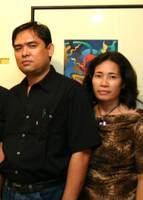
Photo by Danny Sillada. Posted by Hello

